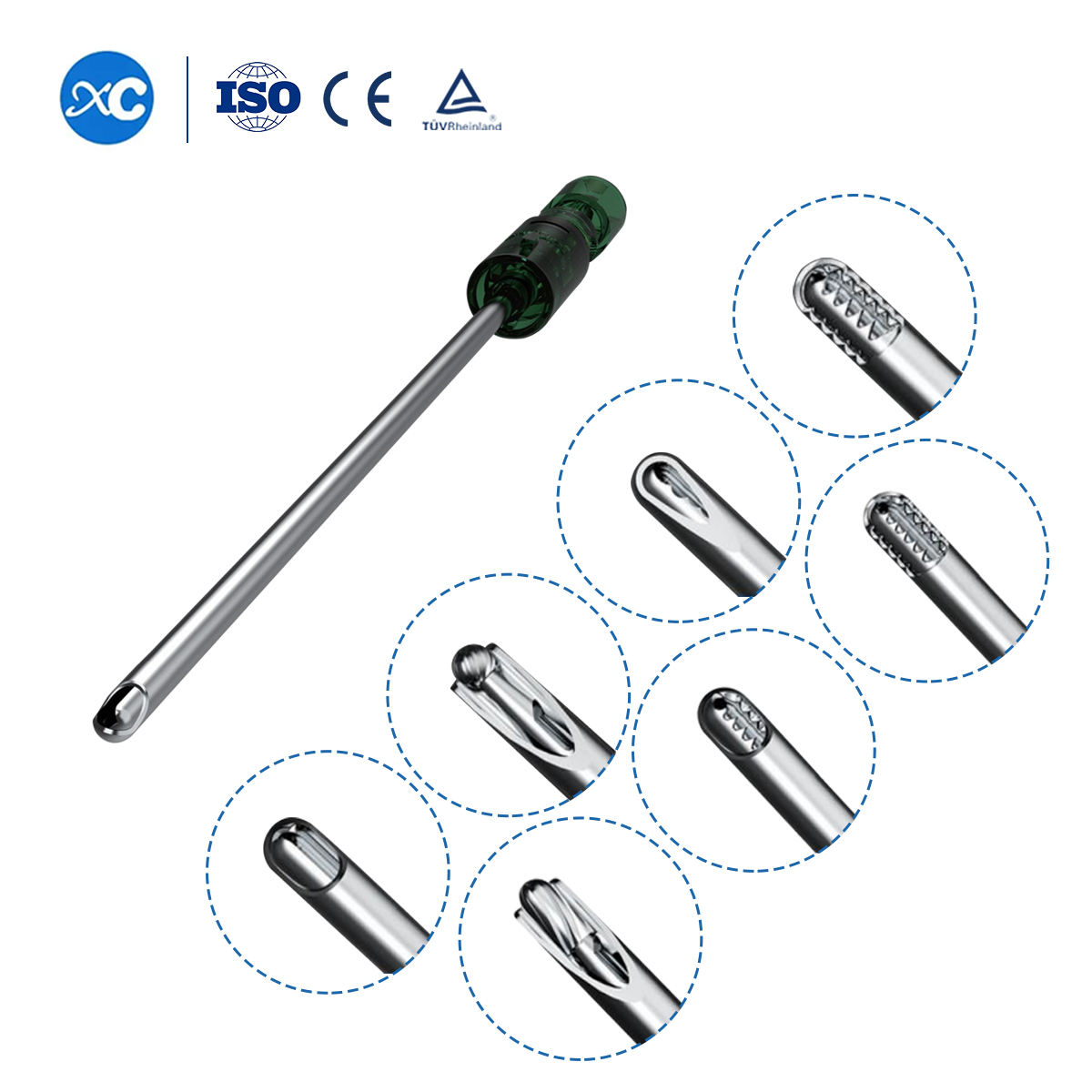Preface
Arthroscopic planer is an instrument used in arthroscopic surgery, mainly used for cutting, scraping, grinding and removing cartilage, ligaments, synovium and other tissues. It usually consists of a handle and an arthroscopic planer. The use of an arthroscopic planer can reduce surgical trauma and bleeding, and improve surgical accuracy and effect.

Arthroscopic planer components
1. Handle:
The handle is typically made of metal or plastic and is used to hold and control the direction and depth of the planer.
2. Blade:
The blade is the main component of the arthroscopic planer and is typically made of high-strength stainless steel. Blades come in various shapes and sizes, depending on the surgical procedure.
3. Head:
The head is the portion of the blade, typically made of carbide, used for cutting, scraping, grinding, and removing tissues such as cartilage, ligaments, and synovium. Heads also come in various shapes and sizes, depending on the surgical procedure.
4. Connector:
The connector connects the handle to the blade or head. It is typically made of metal and offers a certain degree of flexibility and durability.
Arthroscopic planer classification
1. Classification by Blade Shape:
Arthroscopic shavers come in a variety of blade shapes, including round, flat, tapered, spherical, and toothed. Different blade shapes are suitable for different surgical procedures.
2. Classification by Blade Shape:
Arthroscopic shavers come in a variety of blade shapes, including straight, curved, and serrated. Different blade shapes are suitable for different surgical procedures.
3. Classification by Blade Material:
Arthroscopic shavers come in a variety of blade materials, including stainless steel, carbon steel, and ceramic. Blades of different materials have different characteristics and applications.
4. Classification by Handle Shape:
Arthroscopic shavers come in a variety of handle shapes, including straight, curved, and T-shaped. Different handle shapes are suitable for different surgical procedures.
Clinical application of arthroscopic planer
Arthroscopic shavers are widely used clinically, primarily in arthroscopic surgery. Arthroscopic surgery is a minimally invasive procedure performed using a microscope and arthroscopic instruments, which can reduce surgical trauma and bleeding, shortening patient recovery time. Arthroscopic shavers are one of the key instruments used in arthroscopic surgery and are primarily used in the following areas:
1. Cartilage Repair:
Arthroscopic shavers can be used in cartilage repair surgery, restoring the shape and function of cartilage through cutting, scraping, grinding, and removing cartilage.
2. Ligament Repair:
Arthroscopic shavers can be used in ligament repair surgery, restoring the shape and function of ligaments through cutting, scraping, grinding, and removing ligaments.
3. Synovectomy:
Arthroscopic shavers can be used in synovectomy surgery, reducing joint inflammation and pain through cutting, scraping, grinding, and removing synovium.
4. Bone Resection:
Arthroscopic shavers can be used in bone resection surgery, improving joint deformity and function through cutting, grinding, and removing bone tissue.
Arthroscopic planer precautions
1. Professional training:
Arthroscopic planers are specialized instruments and require professional training and instruction before use to ensure safe and effective operation.
2. Choosing the appropriate blade and tip:
Select the appropriate blade and tip according to the surgical procedure to avoid surgical failure or complications due to mismatched blades.
3. Operating techniques:
Operating an arthroscopic planer requires skill and experience. Mastering the relevant operating techniques and precautions is crucial to avoid surgical failure or complications due to improper operation.
4. Maintaining aseptic technique:
Arthroscopic surgery requires aseptic technique to prevent infection of the surgical instruments and surgical site.
5. Postoperative care:
After arthroscopic surgery, patients require postoperative care and rehabilitation training to prevent complications and accelerate recovery.
Arthroscopic Shaver Maintenance
Arthroscopic shaver maintenance is crucial to extending the life of the instrument and ensuring surgical effectiveness and safety. The following are essential tips for maintaining an arthroscopic shaver:
1. Instrument Cleaning:
After use, clean the instrument by placing it in a wash basin with warm water and detergent, then rinsing it with clean water. Finally, sterilize it with high-pressure steam.
2. Instrument Storage:
Store the instrument in a dry, ventilated, and dust-free environment, protecting it from moisture, heat, or pressure.
3. Regular Inspection:
Inspect the instrument regularly to check for wear, deformation, or looseness on the blade and tips. Replace any problems promptly.
4. Caution in Usage:
When using an arthroscopic shaver, avoid overuse or improper use to prevent damage or failure.
5. Regular Maintenance:
Perform regular maintenance on the instrument, such as replacing the blade and tips, as well as parts, to prevent failure.
English
Русский
简体中文
繁體中文
العربية
Français
Español
Português
Deutsch
italiano
日本語
한국어
Nederlands
Tiếng Việt
ไทย
Polski
Türkçe
አማርኛ
ພາສາລາວ
ភាសាខ្មែរ
Bahasa Melayu
ဗမာစာ
தமிழ்
Filipino
Bahasa Indonesia
magyar
Română
Čeština
Монгол
қазақ
Српски
हिन्दी
فارسی
Kiswahili
Slovenčina
Slovenščina
Norsk
Svenska
українська
Ελληνικά
Suomi
Հայերեն
עברית
Latine
Dansk
اردو
Shqip
বাংলা
Hrvatski
Afrikaans
Gaeilge
Eesti keel
Māori
සිංහල
नेपाली
Oʻzbekcha
latviešu
অসমীয়া
Aymara
Azərbaycan dili
Bamanankan
Euskara
Беларуская мова
भोजपुरी
Bosanski
Български
Català
Cebuano
Corsu
ދިވެހި
डोग्रिड ने दी
Esperanto
Eʋegbe
Frysk
Galego
ქართული
guarani
ગુજરાતી
Kreyòl ayisyen
Hausa
ʻŌlelo Hawaiʻi
Hmoob
íslenska
Igbo
Ilocano
Basa Jawa
ಕನ್ನಡ
Kinyarwanda
गोंगेन हें नांव
Krio we dɛn kɔl Krio
Kurdî
Kurdî
Кыргызча
Lingala
Lietuvių
Oluganda
Lëtzebuergesch
Македонски
मैथिली
Malagasy
മലയാളം
Malti
मराठी
ꯃꯦꯇꯥꯏ (ꯃꯅꯤꯄꯨꯔꯤ) ꯴.
Mizo tawng
Chichewa
ଓଡ଼ିଆ
Afaan Oromoo
پښتو
ਪੰਜਾਬੀ
Runasimi
Gagana Samoa
संस्कृत
Gaelo Albannach
Sepeti
Sesotho
chiShona
سنڌي
Soomaali
Basa Sunda
Wikang Tagalog
Тоҷикӣ
Татарча
తెలుగు
ትግንያውያን
Xitsonga
Türkmençe
संस्कृत
ئۇيغۇرچە
Cymraeg
isiXhosa
ייִדיש
Yorùbá
isiZulu




